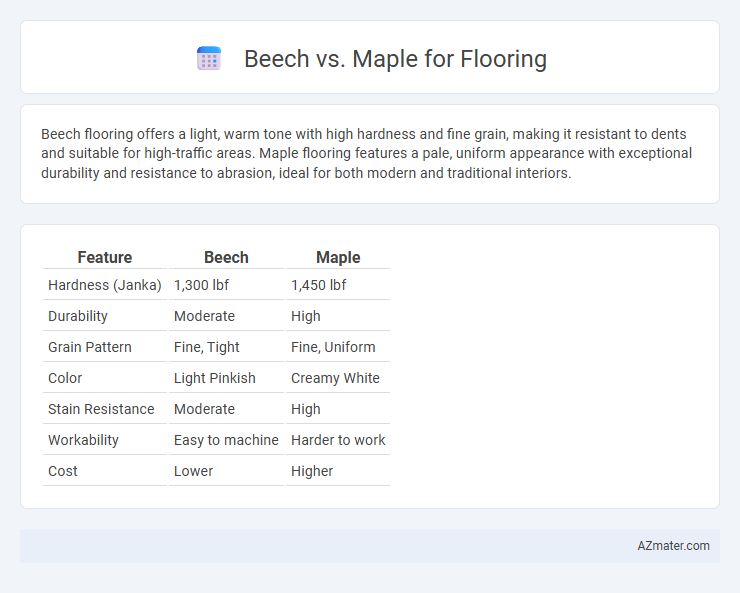Beech flooring offers a light, warm tone with high hardness and fine grain, making it resistant to dents and suitable for high-traffic areas. Maple flooring features a pale, uniform appearance with exceptional durability and resistance to abrasion, ideal for both modern and traditional interiors.
Table of Comparison
| Feature | Beech | Maple |
|---|---|---|
| Hardness (Janka) | 1,300 lbf | 1,450 lbf |
| Durability | Moderate | High |
| Grain Pattern | Fine, Tight | Fine, Uniform |
| Color | Light Pinkish | Creamy White |
| Stain Resistance | Moderate | High |
| Workability | Easy to machine | Harder to work |
| Cost | Lower | Higher |
Introduction to Beech and Maple Flooring
Beech flooring offers a pale cream to light reddish-brown color with a smooth, fine grain that creates a uniform appearance ideal for modern and traditional interiors. Maple flooring features a light, natural tone with subtle grain patterns, providing durability and resistance to wear, making it suitable for high-traffic areas. Both hardwood options are prized for their hardness and longevity, but Beech tends to be more responsive to staining while Maple retains its pale aesthetic naturally.
Key Differences Between Beech and Maple Wood
Beech wood features a fine, tight grain with a uniform texture, offering a pale cream to reddish-brown color, while maple showcases a more pronounced grain pattern with a light, creamy hue often interspersed with subtle flecks or waves. In terms of hardness, both woods rank high on the Janka hardness scale, with hard maple typically measuring around 1450, making it slightly harder and more resistant to dents compared to beech's rating of approximately 1300. Beech tends to be more stable with less movement in humid conditions, whereas maple's denser structure provides superior durability, making it a preferred choice for high-traffic flooring applications.
Appearance and Grain Patterns
Beech flooring features a pale, warm tone with a consistent, fine grain pattern that creates a smooth and uniform surface, ideal for modern and minimalist interiors. Maple flooring exhibits a light, creamy color with subtle variations and a distinctive swirling grain pattern, adding character and visual interest to traditional or contemporary spaces. Both hardwoods offer durability, but maple's diverse grain patterns provide a more dynamic aesthetic compared to the understated elegance of beech.
Hardness and Durability Comparison
Beech flooring offers a Janka hardness rating of around 1,300, making it moderately hard and suitable for high-traffic areas, while maple boasts a Janka hardness of approximately 1,450, indicating slightly greater resistance to dents and wear. Durability-wise, maple tends to outperform beech due to its dense grain structure, providing enhanced resilience against scratches and daily usage. Both hardwoods are popular for flooring, but maple's superior hardness makes it a preferred choice for long-lasting durability in residential and commercial spaces.
Maintenance Requirements
Beech flooring requires regular cleaning to prevent dirt buildup but is known for its durability and resistance to wear, making it easier to maintain in high-traffic areas. Maple flooring demands consistent sweeping and occasional refinishing due to its hardness, which helps resist scratches but can show dents more prominently than beech. Both types benefit from avoiding excessive moisture and using protective finishes to preserve their appearance and longevity.
Cost and Value Considerations
Beech flooring typically costs between $3 to $5 per square foot, offering a balance of affordability and durability suitable for moderate-traffic areas. Maple flooring, priced around $4 to $7 per square foot, provides higher hardness and long-term value, making it ideal for high-traffic spaces despite the higher initial investment. Considering life cycle cost, maple often yields better resale value due to its superior durability and aesthetic appeal.
Suitability for Different Room Types
Beech flooring offers a smooth, hardwearing surface ideal for high-traffic areas such as kitchens and hallways due to its durability and resistance to dents. Maple's fine grain and light tone enhance brightness, making it suitable for living rooms and bedrooms where a warm, cozy ambiance is desired. Both beech and maple provide excellent stability, but maple's higher hardness rating gives it an edge in resilience against everyday wear and tear.
Environmental Impact and Sustainability
Beech flooring is often lauded for its fast growth rate, making it a more renewable resource compared to slower-growing hardwoods like maple. Maple, while durable, generally comes from slower-growing trees which may contribute to longer replenishment periods and potential environmental strain if not sourced responsibly. Both woods require careful certification checks such as FSC or PEFC to ensure sustainable harvesting practices that minimize ecological disturbances.
Installation Challenges and Tips
Beech flooring demands precise acclimation to moisture due to its high density, which can cause expansion or contraction issues if not properly installed. Maple's hardness presents challenges in cutting and nailing, necessitating pre-drilling and specialized tools to prevent damage during installation. Proper subfloor preparation and moisture barriers are critical for both hardwoods to ensure long-lasting, stable floors resistant to warping.
Which Flooring Is Best: Beech or Maple?
Beech flooring offers a fine, tight grain and a warm, reddish-brown tone that ages gracefully, making it highly durable for high-traffic areas. Maple flooring features a harder, denser wood with a light, creamy color that can withstand heavy wear and provides a smooth, contemporary look. Both options are excellent for hardwood floors, but maple's superior hardness (Janka hardness rating around 1450) often makes it the best choice for durability and longevity in flooring applications.

Infographic: Beech vs Maple for Flooring
 azmater.com
azmater.com